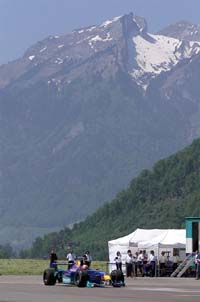'The return of motor racing to Switzerland'
Author
- Mattijs Diepraam
Date
- 8W Autumn 2001 issue
Related articles
- Jos Verstappen - Dutch courage: the unfulfilled promise of Jos Verstappen, by Dan Moakes
Who?Enrique Bernoldi What?Sauber-Petronas C19 Where?Nidwalden When?10 May 2000 |
 |
Why?
The return of motor racing to Switzerland? Well, that's a bit rich for this acceleration session that Swiss F1 regulars Sauber held during the 2000 season. The driver involved was Red Bull protégé Enrique Bernoldi, at that time a favourite for a 2001 race seat. The place is Nidwalden airfield, at the foot of the Swiss Alps.
Here we see Bernoldi preparing for some straightline aerodynamics and data logging tests on the Nidwalden runway - and as that doesn't officially constitute circuit racing in the Swiss book of laws the authorities turned a blind eye. They already did the same in 1998 when said Bernoldi did a similar exercise with the C17 on Buochs military airfield near Luzern, while Karl Wendlinger in an Ilmor-powered C12 had the honour of driving a racing car in anger on Swiss territory for the first time since the Le Mans disaster of 1955. Sauber himself of course made a big deal out of that, issuing a press statement very much to the lines of motor racing's return to Helvetia.
However, a visit to the once glorious Bremgarten park circuit at Berne shows that the Swiss don't care about the sport at all - anymore. All their former fame gained through the Swiss GP and drivers such as Toulo de Graffenried, Rudi Fischer, Jo Siffert and Clay Regazzoni has vanished into the country's collective memory's black hole. The only thing around the Bremgarten track - or what is left of it - reminding us of the great races of the past is this home-made and heartfelt memento mori to Achille Varzi, nailed to a tree on the old forest back stretch of the track - which is now, weep not, a cycling path… That a full-blown Grand Prix team should come from a Swiss town called Hinwil is actually an obversation that can be made with some cheek, these days.
As for Bernoldi, he was eventually snubbed by Peter Sauber who plucked the completely unknown Kimi Räikkönen out of the British Formula Renault Championship to give the Finn a Formula 1 race seat after just 12 car races - a new record, consummately beating Jarno Trulli's number of 26 races. Räikkönen's signing angered Sauber's long-time backer Dirk Mateschitz, the owner of Austrian powerdrink empire Red Bull (how much of those silver and blue cans will the world have bought to create this empire?) who instantly grabbed part - and, for 2002, all - of his money and took it to Arrows, where he also conveniently placed the ex-Red Bull F3000 racer from Brazil - apparently one of the drink's "expanding markets".
For a time there was talk of Mateschitz already leaving Sauber altogether after having sat out his 2001 contract but ever the opportunist, the Red Bull boss saw Sauber's youngsters and Sergio Rinland's C20 chassis make infinitely more waves than his own man in the underdeveloped and increasingly embarrassingly underpowered Arrows. Which means the Red Bull Sauber Petronas moniker stayed alive and well for 2001. For 2002, however, Bernoldi doesn't need to look to Sauber for a drive, as Red Bull has switched its support to Arrows completely, where he will probably be joined by Prost refugee Heinz-Harald Frentzen. And the new Arrows designer? The very same Rinland!
So where does that leave Jos Verstappen and his Arrows contract for 2002 and 2003? Well, probably nowhere, as contracts still have buy-out clauses. And with Jos' public bashing of Bernoldi as his "worst team mate ever" and his late-season tail-off in race performance - even causing his engineers to accuse him of "driving like a wanker" after Suzuka! - the flying Dutchman's fate is again sealed at the last gasp. And yet again by his own doing. So is Bernoldi taking Jos' place on merit? He did in his debut season outqualify his more experienced team mate. That must account for something, must it not? Well, yes, it shows that Bernoldi is a potent qualifier… In race conditions, however, he was usually well under par, many times losing his qualifying advantage to "Arrows' Human Launch Control" Verstappen in the first few seconds of the race after which the usually low-on-fuel Verstappen managed to pass the cars that Bernoldi didn't. The only thing Enrique showed on race day is that he is a hard man to pass, as David Coulthard and his team mate (at Hockenheim!) will testify.
Bernoldi's qualifying prowess compares well with the excellent one-lap performances of those other youngsters that are marked out as the future of the sport. In his first season Jenson Button came on strong on in the second half of the season to outqualify Ralf on many occasions but this year he has been butchered by an inspired Fisichella. Kimi Räikkönen proved he is the equal of Nick Heidfeld in qualifying but the German marked himself out as the cannier racer, taking Sauber's first podium and the highest World Drivers Championship position in the history of the team. The jury is still out on Fernando Alonso's race performances, as his car rarely enabled him to show his mettle. But his qualifying times were often mesmerizing. Would that mean that young drivers easily adapt to these 800bhp go-karts when running in clean air? That it's hard to find an advantage in equal circumstances? And that experience, stamina and race instinct will only shine through on Sundays?
If that's the case, let's hope for McLaren that they picked the right Sauber driver. Or that they come up with a car that will be able to race at the front - where the air is always clean…
